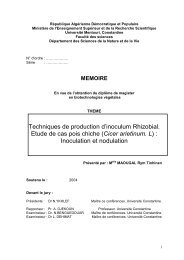(Thèse partie 1)
(Thèse partie 1)
(Thèse partie 1)
Create successful ePaper yourself
Turn your PDF publications into a flip-book with our unique Google optimized e-Paper software.
177<br />
Références bibliographiques<br />
Imhoff, J. & Suling, J. (1996). The phylogenetic relationship among the<br />
Ectothiorhodospiraceae: a reevaluation of their taxonomy on the basis of 16S rDNA analyses.<br />
Arch Microbiol 165, 106-113.<br />
Imhoff, J., Petri, R. & Suling, J. (1998a). Reclassification of species of the spiral-shaped<br />
phototrophic purple non-sulfur bacteria. Int J Syst Bacteriol (sous presse).<br />
Imhoff, J., Suling, J. & Petri, R. (1998b). Phylogenetic relationships among the<br />
Chromatiaceae. Int J Syst Bacteriol (sous presse).<br />
Itoh, T., Yamagushi, T., Zhou, P. & Takashina, T. (2005). Natronolimnobius baerhuensis<br />
gen. nov., sp. nov., and Natronolimnobius innermongolicus sp. nov., novel haloalkaliphilic<br />
archaea isolated from soda lakes in inner Mongolia, China. Extremophiles 9, 11-116.<br />
Ivanov, M. V. (1995). Halophilic archaebacteria from the Kalambass oil field. Microbiol 64,<br />
67-71.<br />
James, S. R., Dobson, S. J., Franzmann, P. D. & McMeekin, T. A. (1990). Halomonas<br />
meridiana, a new species of extremely halotolerant bacteria isolated from Antarctic saline<br />
lakes. Syst Appl Microbiol 13, 270-278.<br />
Javor, B.J. (1983). Planktonic standing crop and nutrients in a saltern ecosystem. Limnol<br />
Oceanogr 28, 153-159.<br />
Javor, B. J. (1984). Growth Potentiel of Halophilic Bacteria Isolated from Solar Salt<br />
Environments: Carbon Sources and Salt Requirements. Appl Environ Microbiol 8, 352-360.<br />
Javor, B. J. (1989). Halophilic Archaebacteria. In Hypersaline Environments Microbiology<br />
and Biogeochemistry. pp. 101-120. Springer- Verlag. Berlin, Germany.<br />
Johnsen, U., Selig, M., Xavier, K. B., Santos, H. & Schönheit, P. (2001). Different<br />
glycolytic pathways for glucose and fructose in the halophilic archaeon Halococcus<br />
saccharolyticus. Arch Mcirobiol 175, 52-61.<br />
Johnson, K. G., Lanthier, P. H. & Gochnauer, M. B. (1986). Studies of two strains of<br />
Actinopolyspora halophila, an extremely halophilic actinomycete. Arch Microbiol 143, 370-<br />
378.<br />
Jones, A. G., Ewing, C. M. & Melvio, M. V. (1981). Biotechnology of solar saltfield.<br />
Hydrobiologia 82, 391-406.<br />
Jones, C. J. & Aizawa, S. (1991). The bacterial flagellum and flagellar motor: structure,<br />
assembly and function. Adv Microbiol Physiol 32, 109-172.<br />
Juez, G. (2004). Extremely Halophilic Archaea: Insigts into Their Response to<br />
Environmental Conditions. In Halophilic Microorganisms. Ed. A. Ventosa. pp. 243-253.<br />
Springer-Verlag Berlin Heidelberg.<br />
Jukes, T. & Cantor, C. (1969). Evolution of protein molecules. In mammalian protein<br />
metabolism. Ed. H. N. Munro. pp. 21-31. Academic press, New York, NY.<br />
Kamekura, M., Hamakawa, T. & Onishi, H. (1982). Application of halophilic nuclease H<br />
of Micrococcus varians subsp. halophilus to commercial production of flavouring agent 5’ –<br />
GMP. Appl Environ Microbiol 44, 994-995.<br />
Kamekura, M. & Onishi, H. (1983). Inactivation of nuclease H of the moderate halophile<br />
Micrococcus varians ssp. halophilus during cultivation in the presence of salting-in type salts.<br />
Can J Microbiol 29, 46-51.<br />
Kamekura, M. & Kushner, D. J. (1984). Effect of chloride and glutamate ions on in vitro<br />
protein synthesis by the moderate halophile Vibrio costicola. J Bacteriol 160, 385-390.

















